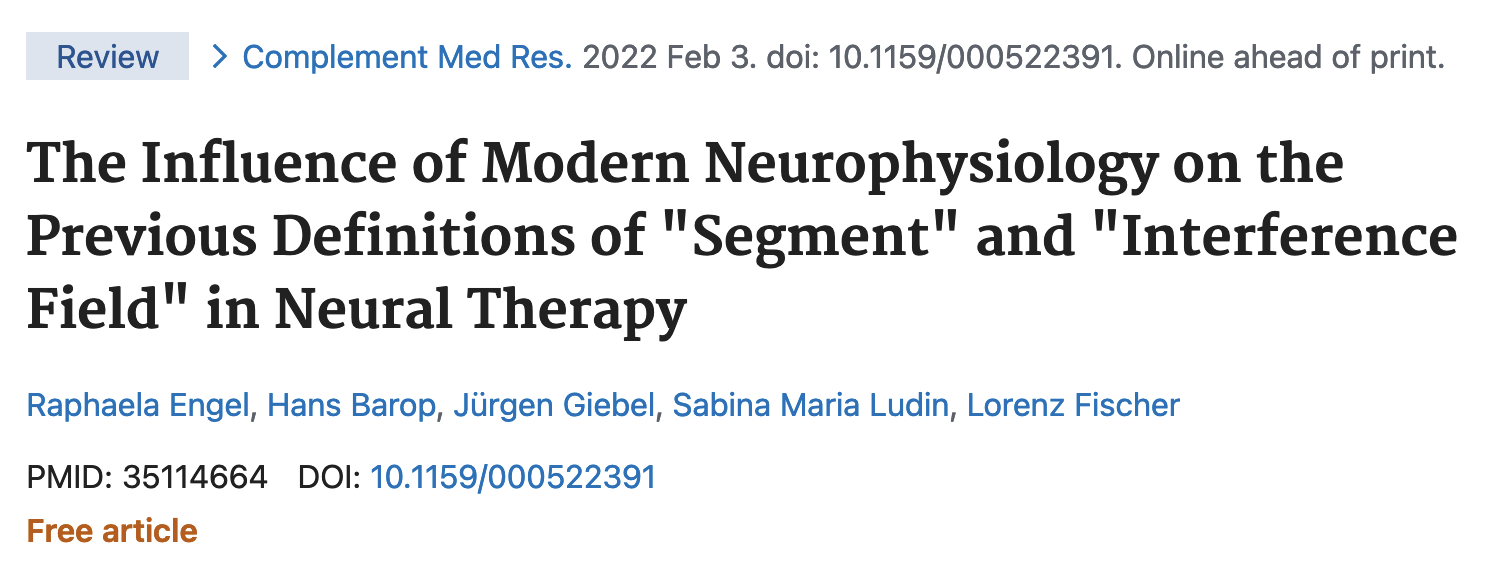 Raphaela Engel (a), Hans Barop (b), Jürgen Giebel (c), Sabina Maria Ludin (d), Lorenz Fischer (a)
Raphaela Engel (a), Hans Barop (b), Jürgen Giebel (c), Sabina Maria Ludin (d), Lorenz Fischer (a)(a) Formerly Neural Therapy, University of Bern, IKIM, Bern, Switzerland
(b) Practice for Neural Therapy, Hamburg, Germany
(c) Institute for Anatomy and Cell Biology, University Medicine Greifswald, Greifswald, Germany
(d) Neural Therapy, University of Bern, IKIM, Bern, Switzerland
Abstract
Background: In neural therapy, local anesthetics are injected for diagnostic and therapeutic purposes. Up until now, a distinction has been made between "local/segmental neural therapy" and "interference field therapy". This division dating back to the middle of the last century was based on the assumption that anatomical and clinical segments were identical. However, this is only true for the projection symptoms, which are limited to metamerism. All pathophysiological processes beyond this segment were called "interference field events" ("outside of any segmental order" and "not explainable by neuroanatomical circuitry").
Summary: However, modern neurophysiology no longer recognizes segmental boundaries, taking into account the occurrence of cross-segmental sensitization processes, neuroplastic changes, immune processes, and neurogenic inflammation. In addition, new insights into neuroanatomical circuitry have also contributed to segmental expansion. Thus, the former definition of the interference field effect (considered to be outside any segmental order) is considered obsolete. Nowadays, interference fields are called "neuromodulatory triggers". They can act anywhere, both locally and fairly distant, and even systemically. Key Message: Thus, it is no longer tenable to classify interference field therapy as "unscientific" and "not recognized" while local and segmental neural therapy is being scientifically recognized.
Conclusion
The historical separation into “local and segmental therapy” and “interference field therapy” in the middle of the last century had its reason in the fact that based on the knowledge of that time the clinical segment was more or less equated with the anatomical, somatic segment (metamerism).
This equation is still correct when projection symptoms are limited to metamerism. All pathophysiological processes which exceeded this “narrowly,” anatomically defined segment were called “interference field events,” i.e., the interference field impulses had an effect far away from the interference field “outside any segmental order” and were “not explicable by neuroanatomical circuitry”. However, these early definitions can no longer be upheld with new neuroanatomical and neurophysiological findings, because in view of sensitization processes, neuroplastic changes, immune and inflammatory processes, segmental boundaries all but vanish or “expand” almost arbitrarily, respectively, and the interference field events become scientifically explainable.
The term “neuromodulatory trigger” is already used synonymously for the term “interference field” or “interference field impulse”. This is in accordance with the Scientific Advisory Board of IFMANT (International Federation of Medical Associations of Neural Therapy).
This clarification of the nomenclature and “abolition” of the clinical segment boundaries in chronic pain and inflammation processes on the basis of modern neurophysiological findings have not changed the basic approach in neural therapy.
Therefore, there is no longer any reason to scientifically separate interference field therapy from segmental therapy (i.e., to classify interference field therapy as unscientific), since with the new findings there is, in principle, no difference. There is a unified explanatory model for neural therapy which knows no “arbitrary” (segmental) boundaries: the (holistic!) neurophysiology and neuroanatomy.
Conclusion
The historical separation into “local and segmental therapy” and “interference field therapy” in the middle of the last century had its reason in the fact that based on the knowledge of that time the clinical segment was more or less equated with the anatomical, somatic segment (metamerism).
This equation is still correct when projection symptoms are limited to metamerism. All pathophysiological processes which exceeded this “narrowly,” anatomically defined segment were called “interference field events,” i.e., the interference field impulses had an effect far away from the interference field “outside any segmental order” and were “not explicable by neuroanatomical circuitry”. However, these early definitions can no longer be upheld with new neuroanatomical and neurophysiological findings, because in view of sensitization processes, neuroplastic changes, immune and inflammatory processes, segmental boundaries all but vanish or “expand” almost arbitrarily, respectively, and the interference field events become scientifically explainable.
The term “neuromodulatory trigger” is already used synonymously for the term “interference field” or “interference field impulse”. This is in accordance with the Scientific Advisory Board of IFMANT (International Federation of Medical Associations of Neural Therapy).
This clarification of the nomenclature and “abolition” of the clinical segment boundaries in chronic pain and inflammation processes on the basis of modern neurophysiological findings have not changed the basic approach in neural therapy.
Therefore, there is no longer any reason to scientifically separate interference field therapy from segmental therapy (i.e., to classify interference field therapy as unscientific), since with the new findings there is, in principle, no difference. There is a unified explanatory model for neural therapy which knows no “arbitrary” (segmental) boundaries: the (holistic!) neurophysiology and neuroanatomy.
